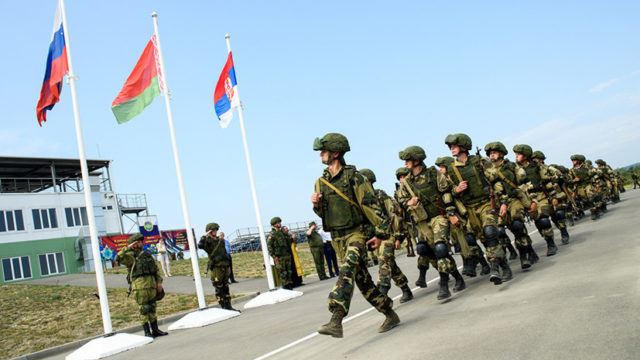
Slavic Brotherhood 2018: Applying the Syrian and Donbas Experience to the Balkans?
Publication: Eurasia Daily Monitor Volume: 15 Issue: 102
By:

During June 18–28, Russia’s southern city of Novorossiysk (Krasnodar Krai) hosted the trilateral joint tactical military exercise Slavic Brotherhood 2018, at the Raevsky training center (Tvzvezda.ru, June 26). Observed by defense attachés from 42 countries, these drills were the largest international maneuvers of the Russian Airborne Troops so far this year, involving 700 soldiers from the Russian side as well as 250 members of the Belarusian special operations forces and 50 Serbian special forces personnel (Mil.ru, June 28). The exercises were designed to rehearse joint actions of a combined task force carrying out peace-making and counter-terrorism operations. Reportedly, the war game involved “virtually all existing types of combat support units” as well as the “broad employment of army aviation” (RIA Novosti, June 21).
The legend of the exercise envisaged a group of terrorists simultaneously attacking a city and a column of coalition forces. The joint tactical groups, comprised of Russian, Belarusian and Serbian forces (in total, eight units brought into the theater by Russian aviation), were to eliminate the adversaries. Anti-terrorist forces engaged in the exercise were to launch a prompt attack against the terrorist groupings (part of the forces were supposed to perform defensive functions in order to prevent the adversaries’ retreat), while the main strike force would be leveled against the rear of the simulated extremist formations. Interestingly, these drills for the first time trained the “principle of sledge and hammer”: Russian forces were supposed to block the adversary forces and deny them freedom of movement within the theater, with Belarusian (and apparently Serbian forces) delivering the final blow (Tvzvezda.ru, June 28).
The exercises featured 10 aircraft (from the Southern Military District) and 150 pieces of hardware and military equipment. Some of this hardware was used for the first time within the scope of a military exercise, including BMD-4M airborne combat vehicles, BTR-MDM Rakushka armored personnel carriers, Rys armored automobiles and T-72B tanks (Mil.ru, June 27).
The Slavic Brotherhood 2018 exercise once again demonstrated Moscow’s special emphasis on developing and deploying Electronic Warfare (EW) capabilities. For example, aside from the multifunctional Infauna intelligence complex (which facilitates communications counter-measures and jams the receivers of enemy radio-controlled explosive devices), an Aistyonok counter-battery radar system was used in these drills. The Aistyonok can reportedly detect the position of fire weapons, calculate the trajectory of incoming shells, as well as control unmanned aerial vehicles (UAV) (Vz.ru, June 25). This equipment was used along with Orlan-10 UAVs (previously tested by Russia in both Syria and Ukraine) to collect information about the simulated enemy’s whereabouts. Additionally, within the scope of these drills, Serbian special forces utilized the Russian future infantry combat system Ratnik, comprised of modernized body armor, a helmet with a special eye monitor, advanced communication systems, and special headphones. Currently, Russia is conducting work on the Ratnik-3 (RIA Novosti, June 21).
Results of this year’s joint Russian-Belarusian-Serbian war games were positively evaluated by all three participating countries. The well-known Russian military expert Lieutenant Colonel (ret.) Vladimir Yazikov particularly highlighted the military-political aspect of Slavic Brotherhood. He noted that the exercise “demonstrated unity and readiness of Russia, Belarus and Serbia to jointly ward off perils threating their national security.” And although “certain contradictions persist between Minsk, Moscow and Belgrade, the level of military-technical cooperation, especially between Russia and Belarus is very high,” Yazikov noted. Moreover, “in a critical time of threat, the Slavic states should be able to form a common front,” he stressed. The retired Russian lieutenant colonel also predicted that, in upcoming years, both the scope and the regularity of such joint events will continue to grow (RT, June 29).
Slavic Brotherhood 2018 takes on a much broader military-strategic significance when looked at against the background of Russia’s involvement in various foreign conflicts in its larger neighborhood, especially Syria. In recent years, many of Russia’s top military strategists have increasingly called for the Russian Armed Forces to capitalize on their “Syrian experience” in order to better prepare for future conflicts and improve their methods of training. Indeed, the necessity to use Syrian lessons in future training and the implementation of the state armament program was repeatedly highlighted by Russian Minister of Defense Sergei Shoigu as well as President Vladimir Putin (Rusvesna.su, January 31; TASS, June 28). Moreover, some Russian mass media outlets (though, without deep elaboration on the subject) have openly claimed that the Slavic Brotherhood drills have become a practical rehearsal of both offensive and defensive military operations based on the experience Russia gained since entering the Syrian civil war in 2015 (RT, June 30).
Aside from the Syrian war, one should keep in mind Russia’s experience gained in various regional conflicts across Europe’s East and the former Soviet space. Of particular note has been the role of Russia’s Airborne Troops (which were also involved in Slavic Brotherhood 2018) in various localized wars in Transnistria, the South Caucasus and, especially, the Balkans. The, so-called “Pristina march” (brosok na Prishtinu) by the Airborne Troops in June 1999, is still widely viewed in Moscow as proof of Russian high morale and military superiority in comparison with the West (Topwar.ru, June 25, 2013).
These ideas were recently emphasized by prominent Russian military expert Lieutenant General Yuri Netkachev, who presumed that the tactics being tested during Slavic Brotherhood 2018 could well be used “in the Donbas region and in the Balkans, namely in Kosovo, which must be seen as an integral part of Serbia.” The general, however, underscored that “this will happen later. For now, the situation remains under NATO’s [North Atlantic Treaty Organization’s] control” (Nezavisimaya Gazeta, June 27, 2018).
Given the training range landscape, composition of forces involved, and the operational art being practiced last month, Slavic Brotherhood 2018 should be seen as more applicable to potential operations in the Balkans, and to a lesser extent with Syria and Donbas.



